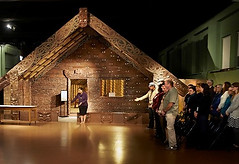
Pacific Anthropology
at the Field Museum
Chicago's Marae
On the upper floor of the Field, visitors will find Ruatepupuke II, a complete 19th century Maori meeting house. It is an artistically and culturally significant building that we are privileged to care for - but its surrounding gallery, the marae, is also central to our mission.




A marae is not just a physical place—a grassy outdoor yard set aside as sacred ground for a meeting house, or in the Museum’s case, an exhibit gallery devoted to the same purpose. A marae in New Zealand is also a liminal space where the past and the present meet, a place where people both honor their forebears and also look to the future.
In Maori terms, a marae is a turangawaewae, a “place to stand,” where people may stand proud, speak, and be heard knowing that they will be received with respect and open-mindedness even by those present who may violently disagree with what they say. In sum, a marae is a place where people may encounter one another, explore their differences, and perhaps discover their commonalities.
It is paradoxical that Chicago has a Maori meeting house and a sacred marae, but lacks a resident Maori community to look after both. To be sure, Chicago receives its share of Maori visitors, and occasional Maori residents. But there is no local Maori community in the city in the sense of a group of people all sharing a common identify, heritage, and purpose. This situation is both a challenge and an opportunity. We must create new ways to keep this Pacific treasure “warm”—as they say in New Zealand.
It is up to Chicago to keep Ruatepupuke alive to its heritage in partnership with the people of Tokomaru Bay.
Children and groups are welcome! But please be respectful of the space and its meaning during your visit.